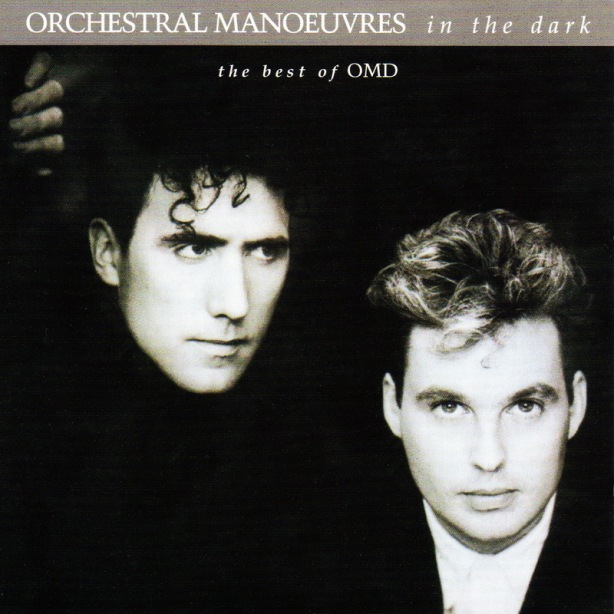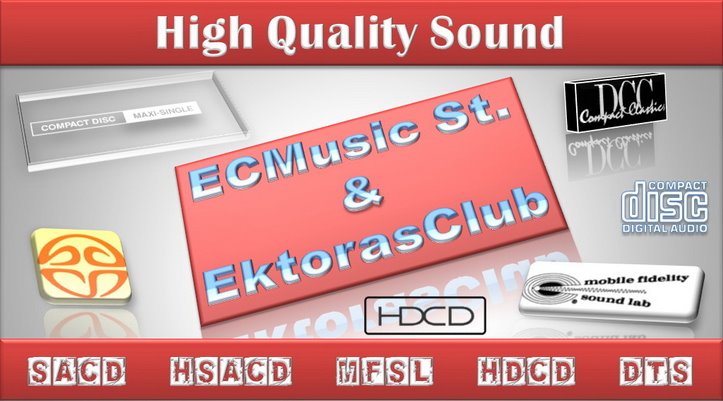
Orchestral Manoeuvres In The Dark - The Best Of OMD
Biography:
Liverpool music scene in the late 1970’s was an exciting and dynamic place to be. Everyone was either in a band, in-between bands or were forming a band. In the midst of all this activity was Eric’s Club – a small discreet venue that was a favoured haunt for the people who would later form bands such as The Teardrop Explodes, Echo & The Bunnymen and Frankie Goes To Hollywood.
So it was quite apt that Eric’s was the venue of choice for the debut performance of Orchestral Manoeuvres In The Dark in October 1978.
Liverpool music scene in the late 1970’s was an exciting and dynamic place to be. Everyone was either in a band, in-between bands or were forming a band. In the midst of all this activity was Eric’s Club – a small discreet venue that was a favoured haunt for the people who would later form bands such as The Teardrop Explodes, Echo & The Bunnymen and Frankie Goes To Hollywood.
So it was quite apt that Eric’s was the venue of choice for the debut performance of Orchestral Manoeuvres In The Dark in October 1978.
Founder members Andy McCluskey and Paul
Humphreys had originally been inspired by the experimental electronic
music of German bands such as Kraftwerk and Neu! Working with radio sets
and home made synthesisers, Humphreys and McCluskey christened
themselves VCLXI (after a valve diagram on the sleeve of Kraftwerk’s
Radioactivity album) and began their own musical experiments. This,
however, was still a side project the pair indulged in on odd weekends
while they were active in local bands such as Equinox, Pegasus and The
Id. Although they had gained a lot of experience from working in a
traditional band environment, it was never quite the creative platform
they were looking for. It was time for a new approach.
Naming themselves after one of their own
early songs, Humphreys and McCluskey launched their own unique style of
catchy electronic melodies that helped form OMD’s reputation for
intelligent pop. Back then, to burden your band with such an unwieldy
name as Orchestral Manoeuvres In The Dark might have
seemed unwise, but the obvious commercial appeal of their music provoked
enough interest that it eventually led to Factory Record’s Tony Wilson
offering them the chance to cut their debut single Electricity on the
Factory label.
Electricity (and its flip side Almost) perfectly captured OMD’s infectious blend of melody and melancholia. Electricity, with its frenetic dance rhythm, rapidly became OMD’s theme song and maintained its status as a live favourite up to the present day. Attracting the interest of Virgin, OMD signed to their subsidiary label Din Disc in 1979.
After a brief period of touring, notably
as support for Gary Numan, OMD quickly established themselves with a
number of classic singles. Messages, with its simple but engaging
melody, managed to get OMD into the public eye in 1980 by reaching No.
13 in the UK charts. Later the same year they made the UK top ten and
scored their first international hit (5 million sales) with the dance
pop of Enola Gay – an up tempo number inspired by the plane that dropped
the atomic bomb on Hiroshima.
The success in 1980 helped OMD to rapidly become one of the UK’s premier pop acts. Their use of extra personnel for live performances led to Humphreys and McCluskey recruiting people in the studio as well with the band soon established as a four piece outfit with the assistance of Martin Cooper (keyboards, saxophone) and Malcolm Holmes (drums).
OMD’s 1981 album, the ethereal
Architecture & Morality proved to be one of their finest moments.
Blending choral effects and wistful melody the album produced three
classic singles: Souvenir with its bittersweet Humphreys vocal, the
religiously inspired Joan Of Arc and its epic follow-up Maid Of Orleans.
All three singles secured a top 5 chart position and by 1982 had turned
OMD into household names.
With 3 hit albums and a string of million selling singles it seemed that the band had a Midas touch. It was about to desert them with the release of their most radical album to date.
The 1983 album Dazzle Ships described a
fractured futurist soundscape of ideas that drew on everything from East
European radio broadcasts to industrial robots for influences. Although
the album concealed some fine pop songs, its lack of critical and
commercial success was perhaps responsible for OMD taking a more
cautious musical path in the future.
OMD’s fifth album Junk Culture from 1984 saw the band steering closer to a more traditional band approach. The instant pop of Tesla Girls, percussive dance flavour of Locomotion and pastoral, dreamlike quality of Talking Loud And Clear proved that they could still deliver classic 3 minute pop songs, while retaining a flavour for the unusual.
Producer Stephen Hague was drafted in for
the 1985 album Crush and the subsequent 1986 album The Pacific Age.
Hague managed to give the songs on both albums a polished edge, while
retaining an essential energy that was vital to the songs. Singles such
as So In Love and (Forever) Live & Die drew on OMD’s flair for
writing engaging melodies, while demonstrating that they were taking
much more of a traditionalist approach to song production.
This period also saw the band touring extensively in North America. If You Leave, specifically written for the John Hughes movie Pretty In Pink, was a huge success. However, the consistent schedule of touring took a toll on the band both professionally as well as personally and the 1988 single Dreaming was, at the time, the last single written by Humphreys and McCluskey.
OMD ended an era in 1989 with the
departure of Humphreys, Holmes and Cooper leaving Andy McCluskey to
forge ahead under the OMD banner. This resulted in the 1991 album Sugar
Tax. It was a brash and dynamic approach that fused the classic OMD
sound with a more mainstream 90’s dance style. Sugar Tax managed to win
over a lot of new converts, as well as the die-hard OMD enthusiast, with
singles such as the spectacular Sailing On The Seven Seas and the dance
pop of Pandora’s Box (a paean to silent movie star Louise Brooks).
OMD followed up on the success of Sugar Tax with the 1993 album Liberator. This album saw OMD broadening their field of influences with the Barry White inspired Dream Of Me (Based On Love’s Theme).
Following the Liberator tour, Andy
McCluskey took some extended time off to reflect and consider OMDs
future. Suitably refreshed, he began writing again – taking a unique
musical direction. The result of this work was premiered in 1996 with
the release of a new single Walking On The Milky Way and the follow-up
album Universal. With its mix of ethereal ambience and epic production
Universal captured a sense of wistful mood that hinted at early OMD, yet
still had a unique style and character that was very much its own.
OMD were effectively retired for the
latter part of the 1990’s while Andy McCluskey focused on management and
production, most notably for the girl pop trio Atomic Kitten who scored
a No. 1 hit single in 2001 with the McCluskey co-written song Whole
Again.
Finally, deciding the time was right for an OMD revival, Andy McCluskey and Paul Humphreys reunited alongside former band members Mal Holmes and Martin Cooper. In 2007 they embarked on an extensive UK and European tour showcasing their classic Architecture & Morality album. As well as playing the album in its entirety, the band also presented a stage show of their most classic hits to a spectacular visual backdrop.
The 2007 Architecture & Morality tour served as a reminder of what an engaging band OMD were live. They had lost none of the power or the impact that they had demonstrated on those early 80’s performances. With a new album on the way and more live performances scheduled for the future, OMD continue to delight and entertain audiences globally.~Paul Browne
Album Notes
The Best of OMD is a compilation album by Orchestral Manoeuvres in the Dark, released in 1988. Despite the band’s waning popularity both in the UK and abroad, it sold extremely well.
The Best of OMD is a compilation album by Orchestral Manoeuvres in the Dark, released in 1988. Despite the band’s waning popularity both in the UK and abroad, it sold extremely well.
The version of “Electricity” used is the
same as the one featured on their debut album (which itself is the band
reworking Martin Hannett’s original Factory version). The band were
originally going to use their very first version of this song, but found
the drumming to be inferior and so settled for the remix of the track
instead. “Messages” is the more popular 10″ single version. “Tesla
Girls” and “Talking Loud and Clear” are both 7″ edited versions. The
Australian version of the album featured “We Love You” since that song
had been a popular hit there.
The CD, MiniDisc and DCC versions of the
album are resequenced and feature four extra tracks not present on the
LP version: “Telegraph” (a unique mix differing from the album version),
“Genetic Engineering”, “La Femme Accident (12″)” and “We Love You
(12″)”.
| EC0932 | Orchestral Manoeuvres In The Dark – The Best Of OMD |
| Label: | Disky |
| Catalog#: | VI 793582 |
| Format: | CD [Compilation] |
| Label Code: | LC 11955 |
| Released: | 2002 by Disky / 1988 Virgin Records |
| Barcode: | 0 724357 935821 |
| Style: | New Wave, Pop/Rock, Synth-pop |
============================================================================ Orchestral Manoeuvres In The Dark – The Best Of OMD
============================================================================
01. Electricity
02. Messages
03. Enola Gay
04. Souvenir
05. Joan Of Arc
06. Maid Of Orleans
07. Telegraph
08. Tesla Girls
09. Locomotion
10. Talking Loud And Clear
11. So In Love
12. Secret
13. If You Leave
14. Forever Live And Die
15. Dreaming
16. Genetic Engineering
17. We Love You (12″ Version)
18. La Femme Accident (12″ Version) Total Time: 01:13:44
Credits ▼
Management [Direct Management Group, Los Angeles And London] – Martin Kirkup, Steve Jensen
Performer [Also Playing With Omd Are] – Graham Weir, Neil Weir
Performer [Omd Are] – Andy McCluskey, Malcolm Holmes, Martin Cooper, Paul Humphreys
Written-By – Troeller (tracks: 9), OMD, Steven Hague (tracks: 11)
Notes ▼
Track 1 ℗ 1979, tracks 2, 3 ℗ 1980, tracks 4, 5 ℗ 1981, track 6 ℗ 1982, tracks 7, 16 ℗ 1983, track 8, 9, 10 ℗ 1984, tracks 11, 12, 18 ℗ 1985, tracks 13, 14, 17 ℗ 1986, track 15 ℗ 1988 Virgin Records, Ltd.
℗ & © 1988 Virgin Records Ltd.
Marketed and distributed in 2002 by Disky Communications Europe B.V., The Netherlands. Printed in EU.
[CD:] Made in EU.
Barcode and Other Identifiers ▼
Barcode (String): 0724357935821
Barcode (Text): 0 724357 935821
Matrix / Runout: DOCdata DISKY VI 793582
Mastering SID Code: IFPI LJ82
Mould SID Code: IFPI 3614
Rights Society: BIEM/STEMRA
Label Code: LC 11955








No comments:
Post a Comment